
Tricholoma is a genus of fungus that contains many fairly fleshy white-spored gilled mushrooms which are found worldwide generally growing in woodlands. These are ectomycorrhizal fungi, existing in a symbiotic relationship with various species of coniferous or broad-leaved trees. The generic name derives from Ancient Greek: τριχο-, romanized: tricho-, lit. 'hair' and Ancient Greek: λῶμα, romanized: loma, lit. 'fringe, border' although only a few species have shaggy caps which fit this description.

Entoloma sinuatum is a poisonous mushroom found across Europe and North America. Some guidebooks refer to it by its older scientific names of Entoloma lividum or Rhodophyllus sinuatus. The largest mushroom of the genus of pink-spored fungi known as Entoloma, it is also the type species. Appearing in late summer and autumn, fruit bodies are found in deciduous woodlands on clay or chalky soils, or nearby parklands, sometimes in the form of fairy rings. Solid in shape, they resemble members of the genus Tricholoma. The ivory to light grey-brown cap is up to 20 cm (7.9 in) across with a margin that is rolled inward. The sinuate gills are pale and often yellowish, becoming pink as the spores develop. The thick whitish stem has no ring.
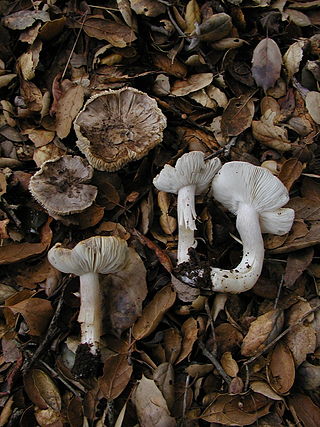
Tricholoma argyraceum is a grey-capped mushroom of the large genus Tricholoma. It has been often confused with the similar-looking Tricholoma scalpturatum.

Tricholoma pardinum, commonly known as spotted tricholoma, tiger tricholoma, tigertop, leopard knight, or dirty trich, is a gilled mushroom widely distributed across North America, Europe, and parts of Asia. It is generally found in beech woodland in summer and autumn. Two subspecies have been described from southern Europe. First officially described by Christiaan Hendrik Persoon in 1801, T. pardinum has had a confusing taxonomic history that extends over two centuries. In 1762, German naturalist Jacob Christian Schäffer described the species Agaricus tigrinus with an illustration corresponding to what is thought to be T. pardinum, and consequently, the name Tricholoma tigrinum has been used erroneously in some European field guides.

Pleurotus dryinus, commonly known as the veiled oyster mushroom, is a species of fungus in the family Pleurotaceae. It grows on dead wood and is also a weak pathogen; infecting especially broad-leaved trees.
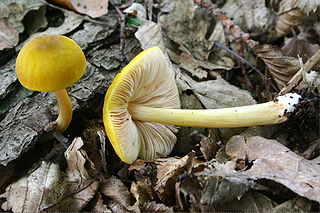
Pluteus leoninus, commonly known as lion shield, can occasionally be found growing on dead wood in Europe and North Africa. The underside of the cap is typical of the genus Pluteus — the gills are pale, soon becoming pink when the spores ripen. But the upper surface is a bright tawny or olivaceous yellow. The species name leoninus refers to this cap colour.
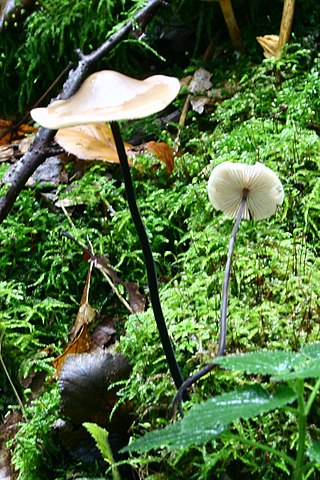
Mycetinis alliaceus, commonly known as the garlic parachute, is one of the larger mushrooms formerly in the genus Marasmius, having a beige cap of up to 4 cm and a long tough slender stipe. It emanates a strong smell of garlic, and this is the significance of the Latin species name, alliaceus. It is distributed throughout Europe, being fairly common in some areas and quite rare in others.

Echinoderma asperum or Lepiota aspera, sometimes known commonly as the freckled dapperling, is a large, brownish, white-gilled mushroom, with a warty or scaly cap. It lives in woodland, or on bark chips in parks, and gardens.

Tricholoma terreum, commonly known as the grey knight or dirty tricholoma, is a grey-capped mushroom of the large genus Tricholoma. It is found in coniferous woodlands in Europe, and has also been encountered under introduced pine trees in Australia and New Zealand. It is regarded as edible. A 2014 article speculated that it may be poisonous, but Sitta et al. in 2016 published in the same journal a counter article demonstrating the unfounded nature of such speculation.

Melanoleuca melaleuca is a species of mushroom in the family Tricholomataceae, and it is the type species of its genus Melanoleuca. It is difficult to distinguish from other related species firstly because it is variable, secondly because the taxonomic criteria are often based on characteristics which have later been found to be variable, and thirdly because there is much disagreement between authorities as to exactly how the species should be defined.
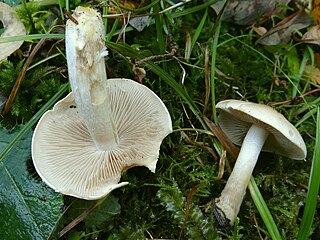
Tricholoma album, commonly known as the white knight, is an all-white mushroom of the large genus Tricholoma. It is found in Europe, India, and possibly North America. The cap and gills are white. The whitish stipe has no ring.
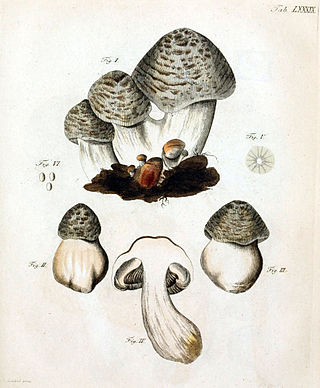
Tricholoma tigrinum is a gilled mushroom. First described under the name Agaricus tigrinus by Jacob Christian Schäffer in 1774, the species was transferred to the genus Tricholoma in 1871 by Paul Kummer.
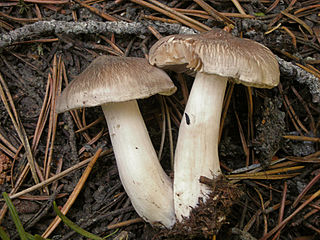
Tricholoma virgatum, commonly known as the ashen knight, is a mushroom of the agaric genus Tricholoma. It was first described scientifically as Agaricus virgatus by Elias Fries in 1818, and later transferred to the genus Tricholoma by Paul Kummer in 1871. It is found in the deciduous and coniferous forests of Europe, North America, and China. The mushroom is inedible, speculated to be poisonous, and has a bitter and peppery taste and musty odor.

Tricholoma imbricatum is a species of agaric fungus in the family Tricholomataceae. Commonly known as the matt knight, it is found in Europe and North America, where it grows on the ground in coniferous forests. Fruit bodies have a brown to reddish-brown cap, which is often scaly, and ranges from 6–18 cm in diameter, and a stipe that is 3.5–12 cm long by 1–3 cm thick. The gills are initially whitish in color before developing reddish-brown spots. The spores are white.
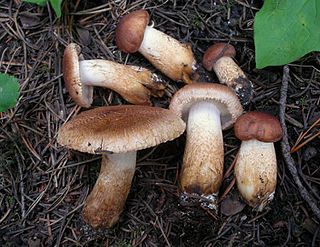
Tricholoma vaccinum, commonly known as the russet scaly tricholoma, the scaly knight, or the fuzztop, is a fungus of the agaric genus Tricholoma. It produces medium-sized fruit bodies (mushrooms) that have a distinctive hairy reddish-brown cap with a shaggy margin when young. The cap, which can reach a diameter of up to 6.5 cm (2.6 in) wide, breaks up into flattened scales in maturity. It has cream-buff to pinkish gills with brown spots. Its fibrous, hollow stipe is white above and reddish brown below, and measures 4 to 7.5 cm long. Although young fruit bodies have a partial veil, it does not leave a ring on the stipe.

Lepiota cristata, commonly known as the stinking dapperling, brown-eyed parasol, or the stinking parasol, is an agaric and possibly poisonous mushroom in the family Agaricaceae. A common and widespread species—one of the most widespread fungi in the genus Lepiota—it has been reported from Europe, northern Asia, North America, and New Zealand. It fruits on the ground in disturbed areas, such as lawns, path and road edges, parks, and gardens. The species produces fruit bodies characterized by the flat, reddish-brown concentric scales on the caps, and an unpleasant odour resembling burnt rubber. Similar Lepiota species can sometimes be distinguished from L. cristata by differences in cap colour, stipe structure, or odour, although some species can only be reliably distinguished through the use of microscopy.

Tricholoma ustale, commonly known as the burnt knight, is a species of mushroom in the large genus Tricholoma. It is found in Asia, Europe, and North America, though those from North America may represent one or more different species.

Pleurotus cornucopiae is a species of edible fungus in the genus Pleurotus, It is quite similar to the better-known Pleurotus ostreatus, and like that species is cultivated and sold in markets in Europe and China, but it is distinguished because its gills are very decurrent, forming a network on the stem.

Infundibulicybe gibba, and commonly known as the common funnel or funnel cap, is a species of gilled mushroom which is common in European woods.



















